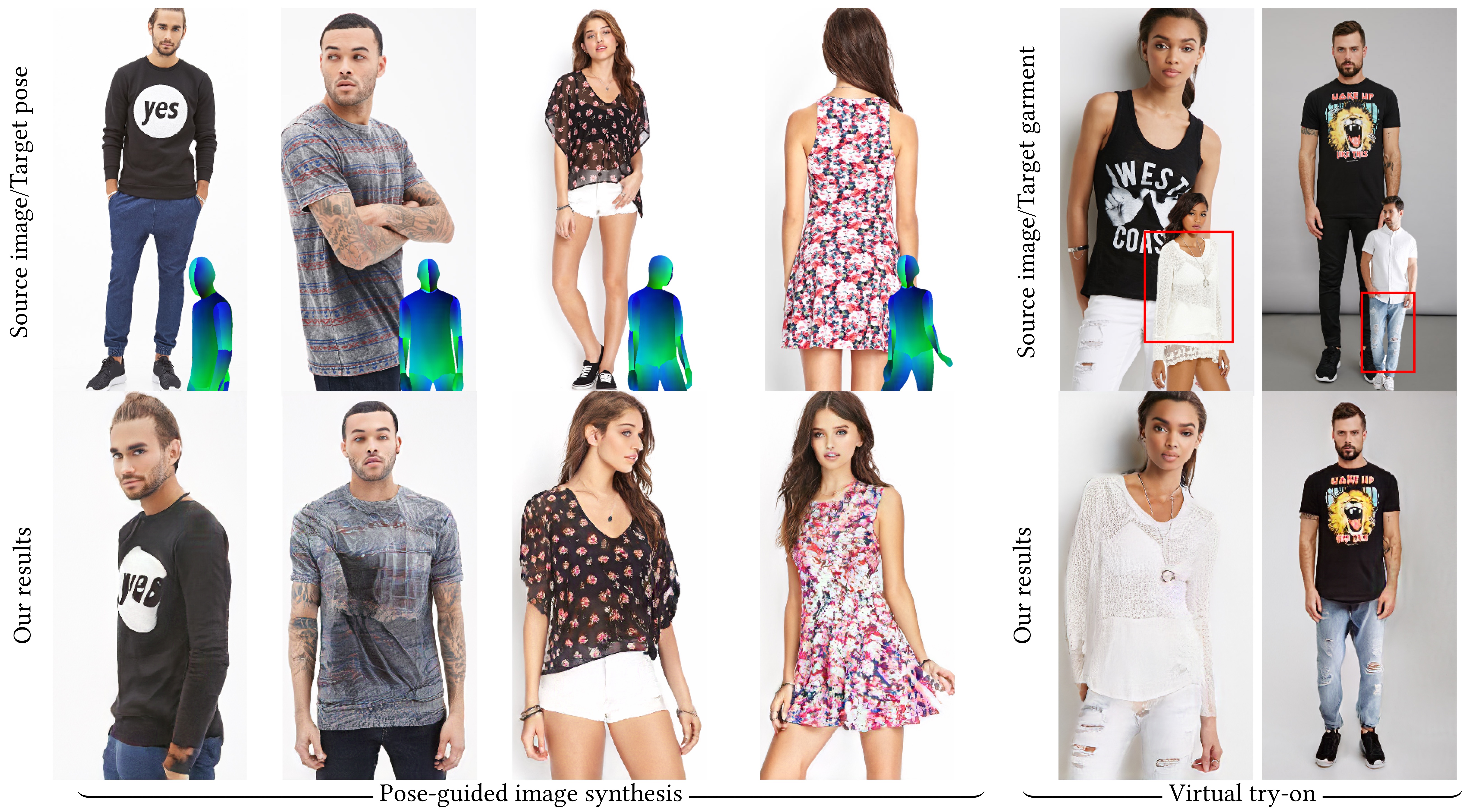Pose with Style: Detail-Preserving Pose-Guided Image Synthesis with Conditional StyleGAN
[Paper] [Project Website] [Output resutls]
Official Pytorch implementation for Pose with Style: Detail-Preserving Pose-Guided Image Synthesis with Conditional StyleGAN. Please contact Badour AlBahar ([email protected]) if you have any questions.
Requirements
conda create -n posewithstyle python=3.6
conda activate posewithstyle
conda install pytorch==1.9.0 torchvision==0.10.0 torchaudio==0.9.0 cudatoolkit=10.2 -c pytorch
pip install -r requirements.txt
Intall openCV using conda install -c conda-forge opencv or pip install opencv-python. If you would like to use wandb, install it using pip install wandb.
Download pretrained models
You can download the pretrained model here, and the pretrained coordinate completion model here.
Note: we also provide the pretrained model trained on StylePoseGAN [Sarkar et al. 2021] DeepFashion train/test split here. We also provide this split's pretrained coordinate completion model here.
Reposing
Download the UV space - 2D look up map and save it in util folder.
We provide sample data in data directory. The output will be saved in data/output directory.
python inference.py --input_path ./data --CCM_pretrained_model path/to/CCM_epoch50.pt --pretrained_model path/to/posewithstyle.pt
To repose your own images you need to put the input image (input_name+'.png'), dense pose (input_name+'_iuv.png'), and silhouette (input_name+'_sil.png'), as well as the target dense pose (target_name+'_iuv.png') in data directory.
python inference.py --input_path ./data --input_name fashionWOMENDressesid0000262902_3back --target_name fashionWOMENDressesid0000262902_1front --CCM_pretrained_model path/to/CCM_epoch50.pt --pretrained_model path/to/posewithstyle.pt
Garment transfer
Download the UV space - 2D look up map and the UV space body part segmentation. Save both in util folder. The UV space body part segmentation will provide a generic segmentation of the human body. Alternatively, you can specify your own mask of the region you want to transfer.
We provide sample data in data directory. The output will be saved in data/output directory.
python garment_transfer.py --input_path ./data --CCM_pretrained_model path/to/CCM_epoch50.pt --pretrained_model path/to/posewithstyle.pt --part upper_body
To use your own images you need to put the input image (input_name+'.png'), dense pose (input_name+'_iuv.png'), and silhouette (input_name+'_sil.png'), as well as the garment source target image (target_name+'.png'), dense pose (target_name+'_iuv.png'), and silhouette (target_name+'_sil.png') in data directory. You can specify the part to be transferred using --part as upper_body, lower_body, or face. The output as well as the part transferred (shown in red) will be saved in data/output directory.
python garment_transfer.py --input_path ./data --input_name fashionWOMENSkirtsid0000177102_1front --target_name fashionWOMENBlouses_Shirtsid0000635004_1front --CCM_pretrained_model path/to/CCM_epoch50.pt --pretrained_model path/to/posewithstyle.pt --part upper_body
DeepFashion Dataset
To train or test, you must download and process the dataset. Please follow instructions in Dataset and Downloads.
You should have the following downloaded in your DATASET folder:
DATASET/DeepFashion_highres
- train
- test
- tools
- train.lst
- test.lst
- fashion-pairs-train.csv
- fashion-pairs-test.csv
DATASET/densepose
- train
- test
DATASET/silhouette
- train
- test
DATASET/partial_coordinates
- train
- test
DATASET/complete_coordinates
- train
- test
DATASET/resources
- train_face_T.pickle
- sphere20a_20171020.pth
Training
Step 1: First, train the reposing model by focusing on generating the foreground. We set the batch size to 1 and train for 50 epochs. This training process takes around 7 days on 8 NVIDIA 2080 Ti GPUs.
python -m torch.distributed.launch --nproc_per_node=8 --master_port XXXX train.py --batch 1 /path/to/DATASET --name exp_name_step1 --size 512 --faceloss --epoch 50
The checkpoints will be saved in checkpoint/exp_name.
Step 2: Then, finetune the model by training on the entire image (only masking the padded boundary). We set the batch size to 8 and train for 10 epochs. This training process takes less than 2 days on 2 A100 GPUs.
python -m torch.distributed.launch --nproc_per_node=2 --master_port XXXX train.py --batch 8 /path/to/DATASET --name exp_name_step2 --size 512 --faceloss --epoch 10 --ckpt /path/to/step1/pretrained/model --finetune
Testing
To test the reposing model and generate the reposing results:
python test.py /path/to/DATASET --pretrained_model /path/to/step2/pretrained/model --size 512 --save_path /path/to/save/output
Output images will be saved in --save_path.
You can find our reposing output images here.
Evaluation
We follow the same evaluation code as Global-Flow-Local-Attention.
Bibtex
Please consider citing our work if you find it useful for your research:
@article{albahar2021pose,
title = {Pose with {S}tyle: {D}etail-Preserving Pose-Guided Image Synthesis with Conditional StyleGAN},
author = {AlBahar, Badour and Lu, Jingwan and Yang, Jimei and Shu, Zhixin and Shechtman, Eli and Huang, Jia-Bin},
journal = {ACM Transactions on Graphics},
year = {2021}
}
Acknowledgments
This code is heavily borrowed from Rosinality: StyleGAN 2 in PyTorch.
